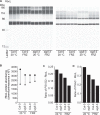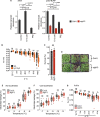Low-temperature and circadian signals are integrated by the sigma factor SIG5
- PMID: 36997687
- PMCID: PMC10119024
- DOI: 10.1038/s41477-023-01377-1
Low-temperature and circadian signals are integrated by the sigma factor SIG5
Abstract
Chloroplasts are a common feature of plant cells and aspects of their metabolism, including photosynthesis, are influenced by low-temperature conditions. Chloroplasts contain a small circular genome that encodes essential components of the photosynthetic apparatus and chloroplast transcription/translation machinery. Here, we show that in Arabidopsis, a nuclear-encoded sigma factor that controls chloroplast transcription (SIGMA FACTOR5) contributes to adaptation to low-temperature conditions. This process involves the regulation of SIGMA FACTOR5 expression in response to cold by the bZIP transcription factors ELONGATED HYPOCOTYL5 and ELONGATED HYPOCOTYL5 HOMOLOG. The response of this pathway to cold is gated by the circadian clock, and it enhances photosynthetic efficiency during long-term cold and freezing exposure. We identify a process that integrates low-temperature and circadian signals, and modulates the response of chloroplasts to low-temperature conditions.
© 2023. The Author(s).
Conflict of interest statement
The authors declare no competing interests.
Figures













Similar articles
-
Circadian control of chloroplast transcription by a nuclear-encoded timing signal.Science. 2013 Mar 15;339(6125):1316-9. doi: 10.1126/science.1230397. Science. 2013. PMID: 23493713
-
Integration of light and circadian signals that regulate chloroplast transcription by a nuclear-encoded sigma factor.New Phytol. 2017 Jan;213(2):727-738. doi: 10.1111/nph.14176. Epub 2016 Sep 15. New Phytol. 2017. PMID: 27716936 Free PMC article.
-
The multiple-stress responsive plastid sigma factor, SIG5, directs activation of the psbD blue light-responsive promoter (BLRP) in Arabidopsis thaliana.Plant Cell Physiol. 2004 Apr;45(4):357-68. doi: 10.1093/pcp/pch050. Plant Cell Physiol. 2004. PMID: 15111710
-
Role and regulation of plastid sigma factors and their functional interactors during chloroplast transcription - recent lessons from Arabidopsis thaliana.Eur J Cell Biol. 2010 Dec;89(12):940-6. doi: 10.1016/j.ejcb.2010.06.016. Epub 2010 Aug 10. Eur J Cell Biol. 2010. PMID: 20701995 Review.
-
Roles of chloroplast RNA polymerase sigma factors in chloroplast development and stress response in higher plants.Biosci Biotechnol Biochem. 2004 Nov;68(11):2215-23. doi: 10.1271/bbb.68.2215. Biosci Biotechnol Biochem. 2004. PMID: 15564657 Review.
Cited by
-
Circadian and environmental signal integration in a natural population of Arabidopsis.Proc Natl Acad Sci U S A. 2024 Aug 27;121(35):e2402697121. doi: 10.1073/pnas.2402697121. Epub 2024 Aug 22. Proc Natl Acad Sci U S A. 2024. PMID: 39172785 Free PMC article.
-
Circadian regulation of metabolism across photosynthetic organisms.Plant J. 2023 Nov;116(3):650-668. doi: 10.1111/tpj.16405. Epub 2023 Aug 2. Plant J. 2023. PMID: 37531328 Free PMC article. Review.
-
Effects of Low-Temperature Stress on Physiological Characteristics and Microstructure of Stems and Leaves of Pinus massoniana L.Plants (Basel). 2024 Aug 11;13(16):2229. doi: 10.3390/plants13162229. Plants (Basel). 2024. PMID: 39204665 Free PMC article.
-
Identification of candidate genes controlling cold tolerance at the early seedling stage from Dongxiang wild rice by QTL mapping, BSA-Seq and RNA-Seq.BMC Plant Biol. 2024 Jul 9;24(1):649. doi: 10.1186/s12870-024-05369-x. BMC Plant Biol. 2024. PMID: 38977989 Free PMC article.
-
Regreening mechanisms in cucumber: insights from a CsSIG2 mutation affecting chloroplast development.Theor Appl Genet. 2025 Mar 23;138(4):82. doi: 10.1007/s00122-025-04854-7. Theor Appl Genet. 2025. PMID: 40121605
References
Publication types
MeSH terms
Substances
Grants and funding
- BB/P013511/1/RCUK | Biotechnology and Biological Sciences Research Council (BBSRC)
- BB/T008717/1/RCUK | Biotechnology and Biological Sciences Research Council (BBSRC)
- BB/I005811/2/RCUK | Biotechnology and Biological Sciences Research Council (BBSRC)
- BB/J014400/1/RCUK | Biotechnology and Biological Sciences Research Council (BBSRC)
- 17K07438/Ministry of Education, Culture, Sports, Science and Technology (MEXT)
LinkOut - more resources
Full Text Sources
Molecular Biology Databases

